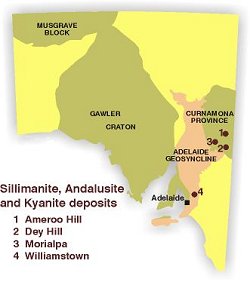 The minerals sillimanite, kyanite and andalusite are all aluminium silicates having the same chemical formula (Al2SiO5) but different crystal structures and physical properties. They form during metamorphism of alumina-rich sediments. Production worldwide in 2013 was 440,000 tonne, mostly andalusite from South Africa, the bulk of which is used for manufacture of mullite (Al6Si2O13) refractories. Conversion to mullite and silica takes place on heating to temperatures in the range 1250–1650°C. Mullite refractories find applications in high-temperature furnaces and kilns, particularly in the iron and steel industry. Demand for these minerals is expected to fluctuate according to the worldwide rise and fall of iron and steel production.
The minerals sillimanite, kyanite and andalusite are all aluminium silicates having the same chemical formula (Al2SiO5) but different crystal structures and physical properties. They form during metamorphism of alumina-rich sediments. Production worldwide in 2013 was 440,000 tonne, mostly andalusite from South Africa, the bulk of which is used for manufacture of mullite (Al6Si2O13) refractories. Conversion to mullite and silica takes place on heating to temperatures in the range 1250–1650°C. Mullite refractories find applications in high-temperature furnaces and kilns, particularly in the iron and steel industry. Demand for these minerals is expected to fluctuate according to the worldwide rise and fall of iron and steel production.
Small and intermittent production of sillimanite and kyanite has been recorded from the Williamstown kaolin deposits, 40 km northeast of Adelaide. These represent areas within the orebody that have not been highly altered to kaolin, and are removed during the initial screening process. Selection of ore for sale requires hand sorting of oversized lump from the screening. All product has been sold for refractories manufacture, with production averaging ~70 t/year over the last decade. The deposit is operated by Unimin Australia Ltd.
Other deposits of sillimanite and andalusite have been mined from scree and shallow trenches in the Olary district near Morialpa and Ameroo Hill. Kyanite schist near Radium Hill contains 6–25% kyanite. Highest grade deposits at Dey Hill have been beneficiated in laboratory tests to give a >98% kyanite concentrate grading 61.7% Al2O3.
Additional Reading
Barnes, L.C., 1990. Williamstown kaolin–sillimanite–mica deposits. In: Hughes, F.E. (Ed.), Geology of the mineral deposits of Australia and Papua New Guinea. Australasian Institute of Mining and Metallurgy. Monograph Series, 14:1163-1166.
Olliver, J.G. and Farrand, M., 1986. Radium Hill kyanite deposits — a review of history, tenure, geology and laboratory testing. South Australia. Department of Mines and Energy. Report Book, 86/50.
Olliver, J.G. and Barnes, L.C., 1988. Olary sillimanite–andalusite deposits — a review of history, tenure and geology. South Australia. Department of Mines and Energy. Report Book, 88/29.


